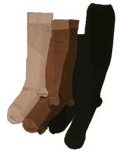Below-Knee Stockings Halve
Complication Rate From Post-Thrombotic Syndrome
Wearing below-knee stockings
after deep vein thrombosis (DVT) reduced the incidence of complications from
post-thrombotic syndrome (PTS) by nearly 50% for up to two years, according
to the results of a randomized trial published in the Aug. 17 issue of the
Annals of Internal Medicine. The editorialist gives a practical approach.
"Because only limited evidence suggests that elastic stocking prevent the
post-thrombotic syndrome in patients with symptomatic deep venous thrombosis
(DVT), these stockings are not widely used," write Paolo Prandoni, MD, PhD, from the University Hospital of Padua in Italy, and colleagues.
from the University Hospital of Padua in Italy, and colleagues.
One third to one quarter of patients with DVT develop complications
including swelling, skin discoloration and numbness, chronic pain,
induration of the skin, and leg ulcerations. Elastic compression stockings
exert graduated pressure on the lower leg and can be purchased in medical
supply stores for U.S. $30 to $50.
In this study, 180 patients diagnosed with a first episode of DVT were
randomized before discharge to wear below-knee graded compression elastic
stockings (30 to 40 mm Hg at the ankle) every day for two years or to not
wear these stockings. All patients also received appropriate anticoagulant
therapy for DVT and were followed up for up to five years. PTS severity was
scored using a standardized scale.
After two years, the group wearing compression stockings had developed fewer
post-thrombotic complications, which occurred in 44 (49%) of 90 controls
(severe in 10) and in 23 (26%) of 90 patients wearing elastic stockings
(severe in 3). The overall incidence of complications was reduced from 49%
to 26%, and the incidence of severe complications was reduced from 12% to
3.5%. However, the stockings did not reduce recurrent episodes of DVT.
The cumulative incidence of PTS in the control group vs the stocking group
was 40.0% (95% confidence interval [CI], 29.9% to 50.1%) vs 21.1% (95% CI,
12.7% to 29.5%) after six months, 46.7% (95% CI, 36.4% to 57.0%) vs 22.2%
(95% CI, 13.8% to 30.7%) after one year, and 49.1% (95% CI, 38.7% to 59.4%)
vs 24.5% (95% CI, 15.6% to 33.4%) after two years. Compared with the control
group, the hazard ratio for PTS in the elastic stockings group was 0.49 (95%
CI, 0.29 to 0.84; P = .01) after adjustment for baseline characteristics.
Study limitations were lack of double-blind design and inability to explain
the mechanism of reduced risk of PTS.
New Medical Service, Linea Flebologica Flebysanin in Rovigo, Italy,
supported this study. The authors report no potential financial conflicts of
interest.
In an accompanying editorial, Jeffrey S. Ginsberg, MD, FRCPC, from McMaster
University in Hamilton, Ontario, offers a practical approach, and Dr.
Ginsberg recommends that stocking therapy be routinely offered after DVT.
"The stockings are sometimes hard to get on; some find them unattractive,
and if the patient has only mild ankle swelling at the end of the day,
frequently elevating the legs or avoiding long bouts of standing or sitting
might be enough to reduce the symptoms," Dr. Ginsberg says. "Still, elastic
compression stockings are a relatively inexpensive, noninvasive way to
reduce risk of complications from DVT, and physicians and patients should
consider them."
Dr. Ginsberg notes that severe symptoms usually indicate extensive thrombus,
causing massive edema, for which a lightweight stocking such as support hose
may be useful until the edema resolves.
"If symptoms persist or worsen despite these measures, or ulceration seems
imminent (as evidenced by severe skin changes), a full-strength stocking (30
to 40 mm Hg of pressure at the ankle) can be prescribed," Dr. Ginsberg
writes. "However, if symptoms subside and the patient remains asymptomatic
or has only trivial persistent signs or symptoms with little or no effect on
quality of life (for example, venous ectasia or mild ankle swelling at the
end of the day), stockings can be avoided and the patient can be followed
for clinically important signs and symptoms of the post-thrombotic
syndrome."
Dr. Ginsberg has received a Career Investigator Award from the Heart and
Stroke Foundation of Ontario. The author reports no potential financial
conflicts of interest.